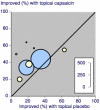Topical capsaicin for chronic neuropathic pain in adults
- PMID: 19821411
- PMCID: PMC4161117
- DOI: 10.1002/14651858.CD007393.pub2
Topical capsaicin for chronic neuropathic pain in adults
Update in
-
Topical capsaicin (high concentration) for chronic neuropathic pain in adults.Cochrane Database Syst Rev. 2013 Feb 28;(2):CD007393. doi: 10.1002/14651858.CD007393.pub3. Cochrane Database Syst Rev. 2013. Update in: Cochrane Database Syst Rev. 2017 Jan 13;1:CD007393. doi: 10.1002/14651858.CD007393.pub4. PMID: 23450576 Updated.
Abstract
Background: Topical creams with capsaicin are used to treat pain from a wide range of chronic conditions including neuropathic pain. Following application to the skin capsaicin causes enhanced sensitivity to noxious stimuli, followed by a period with reduced sensitivity and, after repeated applications, persistent desensitisation. There is uncertainty about the efficacy and tolerability of capsaicin for treating painful chronic neuropathies.
Objectives: To review the evidence from controlled trials on the efficacy and tolerability of topically applied capsaicin in chronic neuropathic pain in adults.
Search strategy: Cochrane CENTRAL, MEDLINE, EMBASE and Oxford Pain Relief Database, searched in May 2009.
Selection criteria: Randomised, double blind, placebo controlled studies of at least six weeks' duration, using topical capsaicin to treat neuropathic pain.
Data collection and analysis: Two review authors independently assessed trial quality and validity, and extracted data. Information was extracted on numbers of participants with pain relief (clinical improvement) after at least six weeks, and with local skin reactions, and used to calculate relative risk and numbers needed to treat to benefit (NNT) and harm (NNH). Details of definition of pain relief and specific adverse events were sought.
Main results: Six studies (389 participants in total) compared regular application of low dose (0.075%) capsaicin cream with placebo cream; the NNT for any pain relief over six to eight weeks was 6.6 (4.1 to 17). Two studies (709 participants in total) compared a single application of high dose (8%) capsaicin patch with placebo patch; the NNT for >/= 30% pain relief over twelve weeks was 12 (6.4 to 70). Local skin reactions were more common with capsaicin, usually tolerable, and attenuated with time; the NNH for repeated low dose application was 2.5 (2.1 to 3.1). There were insufficient data to analyse either data set by condition or outcome definition. All studies satisfied minimum criteria for quality and validity, but maintenance of blinding remains a potential problem.
Authors' conclusions: Capsaicin, either as repeated application of a low dose (0.075%) cream, or a single application of a high dose (8%) patch may provide a degree of pain relief to some patients with painful neuropathic conditions. Local skin irritation, which is often mild and transient but may lead to withdrawal, is common. Systemic adverse effects are rare. Estimates of benefit and harm are not robust due to limited amounts of data for different neuropathic conditions and inconsistent outcome definition.
Figures





Comment in
-
Summaries of nursing care-related systematic reviews from the Cochrane Library: Topical capsaicin for chronic neuropathic pain in adults.Int J Evid Based Healthc. 2010 Sep;8(3):147-8. doi: 10.1111/j.1744-1609.2010.00173.x. Int J Evid Based Healthc. 2010. PMID: 21199383 No abstract available.
References
References to studies included in this review
-
- Backonja M, Wallace MS, Blonsky ER, Cutler BJ, Malan P, Jr, Rauck R, et al. NGX-4010 C107 Study Group NGX-4010, a high-concentration capsaicin patch, for the treatment of postherpetic neuralgia: a randomised, double-blind study. Lancet Neurology. 2008;7(12):1106–12. DOI: 10.1016/S1474-4422(08)70228-X. - PubMed
-
- Bernstein JE, Korman NJ, Bickers DR, Dahl MV, Millikan LE. Topical capsaicin treatment of chronic postherpetic neuralgia. Journal of the American Acadamy of Dermatology. 1989;21(2):265–70. - PubMed
-
- Biesbroeck R, Bril V, Hollander P, Kabadi U, Schwartz S, Singh SP, et al. A double-blind comparison of topical capsaicin and oral amitriptyline in painful diabetic neuropathy. Advances in Therapy. 1995;12(2):111–20. - PubMed
-
- Basha KM, Whitehouse FW. Capsaicin: a therapeutic option for painful diabetic neuropathy. Henry Ford Hospital Medical Journal. 1991;39:138–40. - PubMed
-
-
*
- Capsaicin Study Group Effect of treatment with capsaicin on daily activities of patients with painful diabetic neuropathy. Diabetes Care. 1992;15(2):159–65. - PubMed
-
References to studies excluded from this review
-
- Chad DA, Aronin N, Lundstrom R, McKeon P, Ross D, Molitch M, et al. Does capsaicin relieve the pain of diabetic neuropathy? Pain. 1990;42(3):387–8. - PubMed
-
- Fusco BM, Alessandri M. Analgesic effect of capsaicin in idiopathic trigeminal neuralgia. Anesthesia and Analgesia. 1992;74:375–7. - PubMed
-
- McCarty DJ, Csuka M, McCarthy G, Trotter D. Treatment of pain due to fibromyalgia with topical capsaicin: A pilot study. Seminars in Arthritis and Rheumatism. 1994;23(Suppl 3):41–7.
-
- Paice JA, Ferrans CE, Lashley FR, Shott S, Vizgirda V, Pitrak D. Topical capsaicin in the management of HIV-associated peripheral neuropathy. Journal of Pain and Symptom Management. 2000;19(1):45–52. - PubMed
Additional references
-
- Collins SL, Moore RA, McQuay HJ. The visual analogue pain intensity scale: what is moderate pain in millimetres? Pain. 1997;72(1-2):95–7. - PubMed
-
- Dworkin RH, Turk DC, Wyrwich KW, Beaton D, Cleeland CS, Farrar JT, et al. Interpreting the clinical importance of treatment outcomes in chronic pain clinical trials: IMMPACT recommendations. Journal of Pain. 2008;9(2):105–21. DOI: 10.1016/j.jpain.2007.09.005. - PubMed
-
- Edwards JE, McQuay HJ, Moore RA, Collins SL. Reporting of adverse effects in clinical trials should be improved: lessons from acute postoperative pain. Journal of Pain and Symptom Management. 1999;18(6):427–37. DOI: 10.1016/S0885-3924(99)00093-7. - PubMed
Publication types
MeSH terms
Substances
LinkOut - more resources
Full Text Sources
Other Literature Sources

